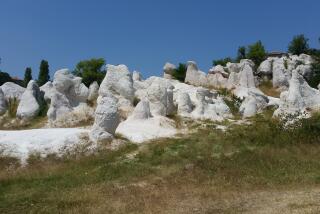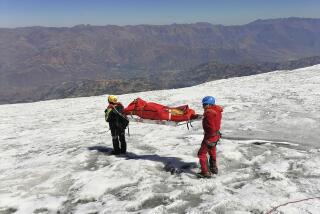On the evolution of peak experiences
Until well into the 1700s, Robert Macfarlane tells us in his wonderfully illuminating book “Mountains of the Mind,” travelers who had to cross the Alps “often chose to be blindfolded in order to prevent them being terrified by the appearance of the peaks.”
Quite apart from the perils of getting across them, most Europeans considered mountains desolate, frightening and downright ugly: “The politer inhabitants of the seventeenth century referred to mountains disapprovingly as ‘deserts’; they were also castigated as ‘boils’ on the earth’s complexion.”
But somewhere in the mid-18th century, attitudes toward altitudes underwent a transformation. Mountains had become sublime. Romantic writers like Rousseau, Wordsworth, Coleridge, Byron, Shelley and Ruskin sought them out and hymned their praises. Tourists kept their eyes wide open to see the spectacular views and experience the thrill of vertigo. Amateur explorers tested their endurance and courage by attempting to ascend them, sometimes with fatal results.
In this, his first book, Cambridge-educated Macfarlane examines the ways in which our response to mountains has been formed or mediated by a rich variety of cultural and intellectual influences. An enthusiastic mountain climber himself, Macfarlane interlards his knowledgeable and beautifully written study with thrilling accounts of his own experiences on the heights.
With impressive perspicacity, Macfarlane locates the first faint inklings of mountain worship in the mid-17th century. Crossing the Alps in 1644, diarist John Evelyn railed against their barrenness, obstructiveness and uselessness. Yet a few weeks later, in the mountains of northern Italy, he was raving about the view. In 1672, Thomas Burnet, going through the Simplon Pass on his way to see Italy’s celebrated classical ruins, also had a surprising experience: “There is something august and stately in the Air of these things,” Burnet wrote, “that inspires the mind with great thoughts and passions.... [A]s all things that are too big for our comprehension, they fill and overbear the mind with their Excess, and cast it into a pleasing kind of stupor and imagination.”
But it was only in 1757 that Edmund Burke’s treatise on the “Sublime and Beautiful” gave a verbal form and conceptual habitation to these inchoate emotions. The Burkean Sublime was but one factor in the growing passion for mountains. In the 18th and 19th centuries, as cities grew more crowded, society more artificial and bourgeois life more safe and comfortable, a longing arose for solitude, wilderness, risk and danger.
Macfarlane also portrays the influence of the emerging science of geology: The Earth, which theologians had dated as a few thousand years old, was suddenly revealed to be millions of years old. Nor were its rivers, oceans and dry land fixed features: Mountains, which once seemed emblems of permanence, were revealed to be the products of eons of change and upheaval.
Knowing even a little about geology, Marfarlane notes, enables “you to see back in time to worlds where rocks liquefy and seas petrify, where granite slops about like porridge, basalt bubbles like stew, and layers of limestone are folded as easily as blankets.... [G]eology ... giddies the sense of the here-and-now.... Contemplating the immensities of deep time you face, in a way that is both exquisite and horrifying, the total collapse of your present....
“Yet there is also something curiously exhilarating about the contemplation of deep time,” he continues. “True, you learn yourself to be a blip in the larger projects of the universe. But you are also rewarded with the realization that ... unlikely as it may seem, you do exist.”
In subsequent chapters, Macfarlane examines and evokes the allure of glaciers, the excitement of exploring the unknown, the “high” that comes with altitude, the sense of freedom from earthly constraints, the visionary beauty of ever-changing light, limpid air and volatile weather, convincing us that there is indeed “another world” to experience in the heights. His book is itself an exhilarating blend of scholarship and adventure, displaying dazzling erudition, acute powers of analysis, a finely honed sense of cultural history and a passionate sense of the author’s engagement with his subject.
On one of the many climbs he describes, Macfarlane’s footing gives way beneath him and he finds himself hanging from the mountainside: “A tingling began in my buttocks and then scampered to my groin and my thighs, and soon my whole midriff was encased in a humming, jostling swarm of fear. The space felt vast and malevolently active, as though it were inhaling me; pulling me off into its emptiness.”
Macfarlane also turns his descriptive gifts to telling the harrowing story of George Mallory, who died in his attempt in 1924 to be the first human being to scale Mt. Everest. As Macfarlane sees it, Mallory -- and others like him -- were unwitting victims of a cultural attitude so pervasive as to be taken for granted. The “mountains of the mind” -- otherworldly, awe-inspiring, magical -- are a far cry from the treacherous, frostbite- and hypothermia-inducing places that mountain climbers actually have to contend with. Yet, as Macfarlane makes clear, the mind needs mountains “to quicken our sense of wonder.”
More to Read
Sign up for our Book Club newsletter
Get the latest news, events and more from the Los Angeles Times Book Club, and help us get L.A. reading and talking.
You may occasionally receive promotional content from the Los Angeles Times.









